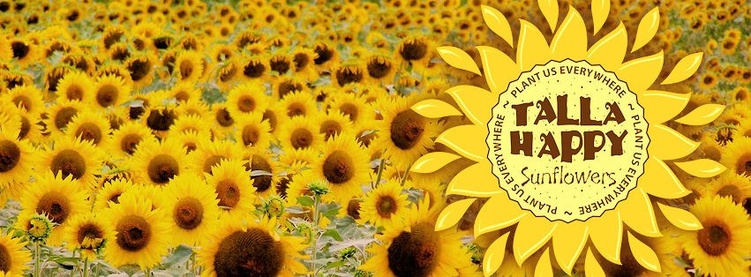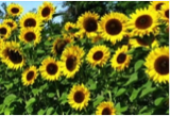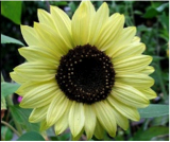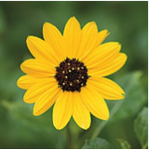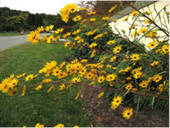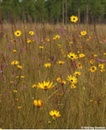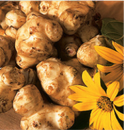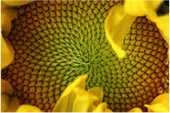Talla-Happy Sunflowers!
The goal of Talla-Happy Sunflowers is to make Tallahassee, Florida the Sunflower capital of the South. Our project grew out of Peter Kageyama’s “For the Love of Cities” program, which was sponsored by Leon County, the City of Tallahassee, the Village Square and the Knight Creative Communities Initiative. The workshop concluded with a challenge to come up with a project to show our love for our community. People at the workshop came up with many great ideas. Two of these ideas were to plant sunflowers all around town, and to create stickers with the slogan, “Talla-Happy.” These ideas were combined and the Talla-Happy Sunflowers were born and given a grant of $500 to buy lots of seeds and tiny packets to put them in. Seed money! So, now you have these seeds, not to eat, but to plant. Thank you for being part of what will soon be a great tradition in Tallahassee - the annual planting of the sunflower seeds!
We welcome you to join and let Leon County and Tallahassee bloom!
For on going updates and opportunities to get involved, please visit the Talla-Happy Sunflowers Facebook Page.
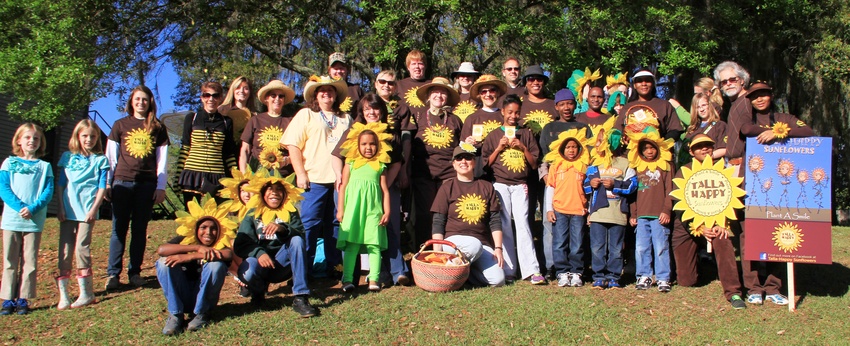 Members of the Talla-Happy Team, ready to plant a smile at the 2013 Springtime Tallahassee Parade.
Members of the Talla-Happy Team, ready to plant a smile at the 2013 Springtime Tallahassee Parade.
How do I get started?
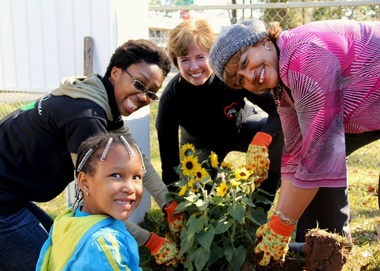 City Commissioner Nancy Miller, City Manager Anita Favors Thompson and friends planting Talla-Happy Sunflowers!Plant the seeds 1-2 inches deep and 8-12 inches apart in loose soil and full sun. Water the seeds daily (twice daily in very hot or dry climates) until the young plants are well established, then water thoroughly every other day. You may stagger plantings over several weeks to allow plants to mature at different times. Weeds should be controlled near sunflowers when the plants are very young, but once sunflowers grow several inches tall they will rapidly become established and weeds are no longer a concern. When stalks grow taller than three feet, stakes can be used to ensure they do not topple over during high winds, storms or when the seed heads become heavy.
City Commissioner Nancy Miller, City Manager Anita Favors Thompson and friends planting Talla-Happy Sunflowers!Plant the seeds 1-2 inches deep and 8-12 inches apart in loose soil and full sun. Water the seeds daily (twice daily in very hot or dry climates) until the young plants are well established, then water thoroughly every other day. You may stagger plantings over several weeks to allow plants to mature at different times. Weeds should be controlled near sunflowers when the plants are very young, but once sunflowers grow several inches tall they will rapidly become established and weeds are no longer a concern. When stalks grow taller than three feet, stakes can be used to ensure they do not topple over during high winds, storms or when the seed heads become heavy.
Varieties to grow in pots:
Orange Hobbit. This little guy is loaded with intensely orange flowers on a dwarf , compact, and highly branched plant that explodes with color in your pot or garden bed. It is ideal for lining a sidewalk or filling the flower bed. Grows 1-2 feet tall. Five week old plugs can easily be transplanted for early spring flowering. ( http://www.sunflowerselections.com)
Little Becka- Grows 2-3 feet tall.
For big spaces:
Amounts below are for Mammoth Grey Stripe:
|
Amount |
Recommended Coverage |
|
Packet |
Up to 10 Sq. Ft |
|
Ounce Package |
Up to 30 Sq. Ft |
|
1/4 Pound Package |
Up to 125 Sq. Ft |
|
1 Pound Sack |
Up to 500 Sq. Ft |
|
5 Pound Sack |
Up to 2,500 Sq. Ft |
Suggested Sunflower Varieties for Tallahassee-Leon County Plantings
The common sunflower, Helianthus annuus, is produced in many varieties as well as in hybrids that provide different bloom sizes, stalk heights and seed yields. Sunflowers need full sun. Most require watering when getting established. Novelty varieties can be found in colors from white to orange to lime (including many varieties that emphasize local university colors!). Choose varieties that produce pollen if you want to provide food for bees and other pollinating insects; sunflower pollen is large and does not induce allergy symptoms.
Tall Varieties:
Mammoth Grey Stripe
- Helianthus annuus, var. “Mammoth Grey Stripe ” is the iconic tall sunflower (but not the very tallest—that’s the Russian mammoth, which grows to 15 feet). Heirloom seeds, native to N. America. Grows 9-12 feet tall and produces flowers about 12 inches. Pollinator friendly & good for pressing sunflower oil. Available as birdseed, and therefore a low-cost choice.
Medium-Height Varieties:
Lemon Queen
Beach Sunflower
Narrow Leaf/Swamp Sunflower
Variable Leaf Sunflower
Jerusalem Artichoke
Zebulon
- Helianthus annus, “Black Oil Sunflower.” Commonly used for birdseed and an economical choice because may contain a very small percentage of other type of seed. Height is ~3 feet, and the plants branch. Songbirds prefer black oil sunflower seeds to striped varieties because the shells are thin and thus easy to crack, and the kernels deliver a powerful nutritional punch in a small package.
- Helianthus annuus, “Lemon Queen.” Grows 5-6 feet tall. Used by people participating in the Great Sunflower Project, the world’s largest citizen science project focused on pollinator conservation. Participants take daily counts of the number and types of pollinators visiting plants (especially sunflowers).
Low-Growing Varieties:
- Helianthus debilis, “Beach Sunflower.” Drought tolerant and Florida native. Candidate for road medians.
- Helianthus angustifolis, “Narrow Leaf/Swamp Sunflower.” Needs moist soil, full sun or high pine shade. Bushy growth bears small, pretty flowers. A perennial and highly available from local grower Dan Miller (Trillium Gardners) [email protected] 893-5757; also a nursery in Milton.
- Helianthus heterophyllus, “Variable Leaf Sunflower.” Also prefers moist soil. A showy plant, also perennial. Not as available. Found in wet prairies and seep slopes and bogs.
Other Native Varieties:
- Helianthus floridanus (native to Northeast FL), Helianthus strumosus, “Pale Leaf Woodland Sunflower,” Helianthus divaricatus, “Woodland Sunflower,” Helianthus hirsutus, “Hairy Sunflower ,” and Helianthus radula, “Stiff/Rayless Sunflower.”
Perennials:
See natives, above. Some nonnative perennials exist as well.
- Helianthus tuberosus, “Jerusalem artichoke,”also known as Sunchokes. A high-yielding, carefree crop that produces edible potato-like tubers often weighing over 1/2 lb. each. They store well and can be eaten raw or cooked. The tall, 6-8', plants with bright yellow blooms make an attractive windbreak, helping to prevent soil erosion. Flowers in July and matures over a month before common varieties. Winter hardy in severe cold. Perennial in Zones 3-8.
Sunflower-like plants:
- Suggested by Florida Native Plant Society: Rosinweed, Florida Greeneyes, Golden Aster, Lanceleaf coreopsis, rudbeckias . There are Florida seed sources for all of these. A ll have long blooming seasons and can grow in our more common habitats.
Novelty Varieties:
- “Zebulon” variety. An attractive dwarf sunflower with an amazing center. Single stem, early flowering, and perfect for fresh bouquets. Ht. 28-36". http://www.johnnyseeds.com.
- FAMU Colors: Just one selection is ProCut Gold. Light green centers, surrounded by orange. http://www.sunflowerselections.com. There are other possibilities!
- FSU Colors: Moulin Rouge, or ProCut red, Ring of Fire, and more…that mix colors.
Recommended Native Plantings to Complement Sunflowers for Leon County
Sunflowers can be expected to stay in bloom for approximately two months and therefore, they’re great to incorporate with other flowers in a flower bed. The list below, provided by Eleanor Dietrich from the Florida Native Plant Society, includes information about complimenting your sunflowers with local native flowers.
|
Common name |
Scientific Name |
Season |
Size |
Light |
|
Butterweed or Golden Ragwort -- an evergreen growncover that has early spring yellow blooms on tall stalks. It slowly creeps and is easily transplanted. Does best with filtered sun and moist soil. |
Packera aurea |
spg |
low |
ps |
|
Green and Gold -- an evergreen groundcover with yellow flowers that bloom in spring and summer. It will send out runners and form colonies. Prefers filtered light. Grows naturally in woodland settings. |
Chrysogonum virginianum |
late winter & early spg |
low |
ps |
|
Lanceleaf Coreopsis or Tickseed -- there are over a dozen species of this State Wildflower. Spreads by reseeding. Tolerates drought and full sun. |
Coreopsis lanceolata |
all |
med |
sun |
|
Softhair Coneflower -- drought tolerant and grows in full sun. Large flowers that bloom in mid-summer. Persists through reseeding. |
Rudbeckia mollis |
summer |
med |
sun |
|
Oxeye Sunflower -- This is a mounding perennial that blooms from spring through fall. It has a delicate form and is very attractive. |
Heliopsis helianthoides |
all |
med |
ps |
|
Starry Rosinweed -- a tall plant covered with beautiful large flowers from late spring through late fall. Drought tolerate and can be grown almost anywhere except dry sandy soil. |
Silphium asteriscus |
sum & fall |
tall |
sun |
|
Brown-Eyed Susan -- a tall plant with small flowers and upper leaves (the lower leaves are larger with 3 lobes). The plant is covered with persistent flowers from summer through fall. It reseeds abundantly. |
Rudbeckia triloba |
sum & fall |
tall |
sun |
|
Cutleaf Coneflower -- a tall mostly evergreen plant that can grow in sun and partial shade. In late summer and through fall it is covered with lovely flowers. It reseeds easily. |
Rudbeckia laciniata |
sum & fall |
tall |
sun/ps |
|
Narrowleaf Sunflower -- this is a brilliant plant of the fall that is tall and can form large colonies. It is very common along damp and sunny rural roadsides. It prefers sun and moist soils. |
Helianthus angustifolius |
fall |
tall |
sun |
|
Gray Headed Coneflower -- grows in a variety of upland habitats that are sunny and have well-drained soils with ample moisture. |
Ratibida pinnata |
sum & fall |
med |
sun/psAdd a caption |
Frequently Asked Questions:
Find up on Facebook: https://www.facebook.com/TallaHappySunflowers

